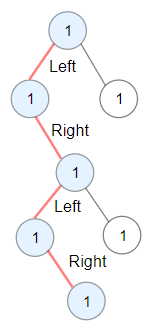You are given the root of a binary tree.
A ZigZag path for a binary tree is defined as follow:
- Choose any node in the binary tree and a direction (right or left).
- If the current direction is right, move to the right child of the current node; otherwise, move to the left child.
- Change the direction from right to left or from left to right.
- Repeat the second and third steps until you can't move in the tree.
Zigzag length is defined as the number of nodes visited - 1. (A single node has a length of 0).
Return the longest ZigZag path contained in that tree.
Example 1:

Input: root = [1,null,1,1,1,null,null,1,1,null,1,null,null,null,1,null,1] Output: 3 Explanation: Longest ZigZag path in blue nodes (right -> left -> right).
Example 2:

Input: root = [1,1,1,null,1,null,null,1,1,null,1] Output: 4 Explanation: Longest ZigZag path in blue nodes (left -> right -> left -> right).
Example 3:
Input: root = [1] Output: 0
题目:给定一棵二叉树,找其中最长的zigzag路。
思路:递归,zigzag路不一定从根节点开始,因此需要记录以每个节点开始的最长zigzag路径,从底部往上回溯。因此从上往下时需要用direction(dir)记录每个节点是左节点还是右节点。如果是左节点(-1代表左节点),则从底部往上时需选择右子节点的zigzag路,如果是右节点(1代表右节点),则需选择其左子节点的zigzag路。根节点用0代表,则选择左子节点或右子节点最长的那条路。代码:
/**
* Definition for a binary tree node.
* struct TreeNode {
* int val;
* TreeNode *left;
* TreeNode *right;
* TreeNode() : val(0), left(nullptr), right(nullptr) {}
* TreeNode(int x) : val(x), left(nullptr), right(nullptr) {}
* TreeNode(int x, TreeNode *left, TreeNode *right) : val(x), left(left), right(right) {}
* };
*/
class Solution {
public:
int helper(TreeNode* node, int& res, int dir){
if(!node) return 0;
int l = helper(node->left, res, -1);
int r = helper(node->right, res, 1);
res = max(res, max(l+1, r+1));
if(dir == -1) return r+1;
if(dir == 1) return l+1;
return max(l,r)+1;
}
int longestZigZag(TreeNode* root) {
int res = 0;
helper(root, res, 0);
return res-1;
}
};





















 1万+
1万+











 被折叠的 条评论
为什么被折叠?
被折叠的 条评论
为什么被折叠?








